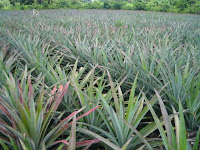How To Cultivate and Grow Pineapple Plant - Pineapple is planted with a population of 24000-72000 plants / ha, depending on the cultivar planted and planting purposes. Pineapple for processing must be planted with low populations (40000-50000 plants / ha) in order to obtain large fruit size, while the pineapple can be grown for fresh consumption with high populations (60000-70000 plants / ha).
Planting on land that has been processed, beginning with making the planting hole. Planting hole made with a drill set, with a depth of 8 cm. Seeds inserted into the hole until the base of the seedlings reach the bottom of the hole, then pressed the surrounding soil. An experienced workforce can plant 2000 seedlings per day. If the seedling death is high (> 10%), then do stitching, so that production targets can be achieved.
Pineapple Plant Fertilization
Pineapple plants require nutrients in sufficient volume to produce well. Nutrients needed each harvest at least 68 kg N, 24 kg P2O5, 174 kg K2O, 27 kg and 16 kg MgO CaO per hectare.
In peatlands, typically the limiting nutrient macro. Therefore need to be micro-nutrients such as CuSO4 and FeSO4. In the garden, FeSO4 one time when 1-month-old plants and CuSO4 given twice a month old plants and 16 months. Both fertilizers were given as leaf fertilizer. CuSO4 (0.15 g / plant) and / or FeSO4 (0.25 g / plant) was dissolved in water and mixed with a solution of CaO (0.6 g / plant) and sprayed on plants.
In peatlands the recommended dose of fertilizer was 14.0 g N, 0.7 g P2O5 and K2O 23.0 g per plant (equivalent to 1,500 kg Urea, 60 kg TSP, and 1,900 kg per hectare with a population of ZK 50 000 plants / ha). Whereas in the sandy clay, the recommended dose is 9.0 g N, 2.4 g P2O5, K2O and 7.0 g per plant (equivalent to 1,000 kg urea, 200 kg TSP and 600 kg per hectare in a population of ZK 50 000 plants plants / ha).
Pineapple Plant Harvest
Starting three months before the harvest every month to do a census fruit for fruit production estimate according to the class. It is very important and related to the planning canning factory. Harvest time is at 128-140 days after Ethrel treatment (or approximately 15 months after planting the seed of puppies). Harvested fruit is a fruit that looks perfect.
Harvesting is done by cutting the fruit stalk with leaves 1.5 to 2.0 cm from the bottom of fruit. For fruit to be processed the crown of fruit was also cut, while the consumption of fresh fruit does not cut the crown.
That information about how cultivate and grow pineapple plant. You must be diligent caring and providing fertilizer and no less important you also have to control pests and diseases of pineapple plant to get pineapple fruit with high quality.
Planting on land that has been processed, beginning with making the planting hole. Planting hole made with a drill set, with a depth of 8 cm. Seeds inserted into the hole until the base of the seedlings reach the bottom of the hole, then pressed the surrounding soil. An experienced workforce can plant 2000 seedlings per day. If the seedling death is high (> 10%), then do stitching, so that production targets can be achieved.
Pineapple Plant Fertilization
 |
In peatlands, typically the limiting nutrient macro. Therefore need to be micro-nutrients such as CuSO4 and FeSO4. In the garden, FeSO4 one time when 1-month-old plants and CuSO4 given twice a month old plants and 16 months. Both fertilizers were given as leaf fertilizer. CuSO4 (0.15 g / plant) and / or FeSO4 (0.25 g / plant) was dissolved in water and mixed with a solution of CaO (0.6 g / plant) and sprayed on plants.
In peatlands the recommended dose of fertilizer was 14.0 g N, 0.7 g P2O5 and K2O 23.0 g per plant (equivalent to 1,500 kg Urea, 60 kg TSP, and 1,900 kg per hectare with a population of ZK 50 000 plants / ha). Whereas in the sandy clay, the recommended dose is 9.0 g N, 2.4 g P2O5, K2O and 7.0 g per plant (equivalent to 1,000 kg urea, 200 kg TSP and 600 kg per hectare in a population of ZK 50 000 plants plants / ha).
Pineapple Plant Harvest
Starting three months before the harvest every month to do a census fruit for fruit production estimate according to the class. It is very important and related to the planning canning factory. Harvest time is at 128-140 days after Ethrel treatment (or approximately 15 months after planting the seed of puppies). Harvested fruit is a fruit that looks perfect.
Harvesting is done by cutting the fruit stalk with leaves 1.5 to 2.0 cm from the bottom of fruit. For fruit to be processed the crown of fruit was also cut, while the consumption of fresh fruit does not cut the crown.
That information about how cultivate and grow pineapple plant. You must be diligent caring and providing fertilizer and no less important you also have to control pests and diseases of pineapple plant to get pineapple fruit with high quality.


Comments
Post a Comment